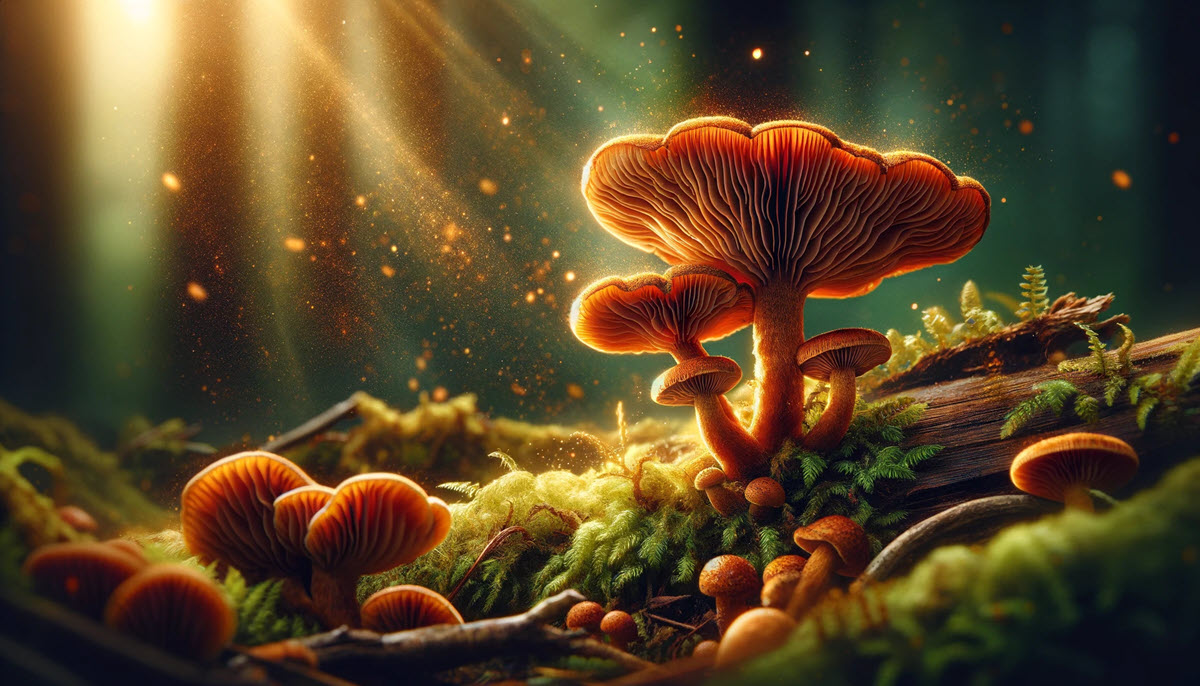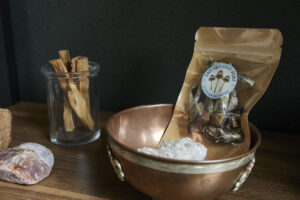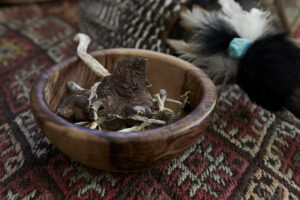Gymnopilus junonius, a mushroom that dances between the realms of beauty and mystery, often goes unnoticed despite its captivating presence. This species, with its vibrant colors and imposing size, invites both awe and caution. Unlike the common mushrooms found in grocery stores, Gymnopilus junonius carries a story untold by many, thriving in the wild where it weaves into the ecosystem’s fabric. This blog post aims to shed light on this fascinating fungus, exploring its characteristics, habitat, and the unique role it plays within nature. By understanding more about Gymnopilus junonius, we not only appreciate its beauty but also grasp the health and complexity of the ecosystems it inhabits.
Key Takeaways
- Gymnopilus junonius, commonly known as the ‘spectacular rustgill’, is a fascinating mushroom with unique characteristics and potential benefits, making it a subject of interest for mycologists, foragers, and culinary enthusiasts.
- Understanding the natural habitats and identifying close relatives and lookalikes are crucial for accurate identification and safe foraging practices, emphasizing the need for thorough research and possibly consultation with experienced mycologists.
- The biochemical makeup of Gymnopilus junonius suggests possible therapeutic applications, though further research is needed to fully explore and validate these potentials.
- Ethical foraging practices are paramount when collecting Gymnopilus junonius or any wild mushrooms, to ensure sustainability and minimal impact on their natural ecosystems.
- Culinary uses and recipes highlight the versatility of Gymnopilus junonius in cooking, but it’s important to note that proper identification and understanding of its properties are essential before consumption.
- Engaging with the mycology community, through forums, social media, or local clubs, can enhance your knowledge, provide valuable identification tips, and deepen your appreciation for Gymnopilus junonius and other fungi.
Unveiling Gymnopilus Junonius
Defining Characteristics
Gymnopilus junonius, also known as laughing gym or laughing jim, stands out in the fungal kingdom. Its cap captivates with a rusty orange to brown color, making it easily recognizable. This hue varies slightly depending on age and environmental conditions.
The mushroom supports its striking cap with a thick, fibrous stem. This robust structure allows it to thrive in various environments. The spore print of Gymnopilus junonius is another critical identifying feature. It presents a distinct color that aids mycologists and enthusiasts in confirming its identity.
Ecological Role
As a decomposer, Gymnopilus junonius plays a vital role in forest ecosystems. It breaks down dead organic matter, turning it into nutrient-rich soil. This process is crucial for nutrient cycling and maintaining healthy soil structure.
Its interaction with other species also marks its ecological significance. Gymnopilus junonius forms relationships with trees, particularly conifers, facilitating mutual benefits within its habitat. These interactions contribute to a balanced ecosystem where various species can flourish.
Global Presence
Gymnopilus junonius has marked its presence across continents including North America, Europe, and Asia. Its adaptability to different climates has been key to this widespread distribution. From temperate forests to subtropical regions, this mushroom finds ways to thrive.
Regions with high concentrations of sightings often boast diverse forest ecosystems. These areas provide the perfect conditions for Gymnopilus junonius to grow and reproduce. As such, they have become hotspots for mycologists and nature enthusiasts eager to observe this fascinating species in its natural habitat.
Close Relatives and Lookalikes
Identifying Features
Gymnopilus junonius stands out with its vibrant cap colors. These caps exhibit a golden-yellow to rusty-brown hue, catching the eye of both amateur and expert mycologists. The presence of a ring on the stem further sets it apart from other fungi. This ring can serve as a crucial identifying marker.
The size of Gymnopilus junonius also varies widely. Caps can range from 5 to 20 cm in diameter. Such variation means they can either dominate the forest floor or blend subtly into their surroundings. Their large size often leads them to be spotted from a distance.
Common Confusions
Despite its distinctive features, Gymnopilus junonius often gets mistaken for its close relatives. One such species is Gymnopilus ventricosus. Both share similar habitats and physical appearances. However, careful observation reveals differences that aid in correct identification.
The spore print color plays a vital role in distinguishing between these two species. It’s an essential step for those looking to identify their finds accurately. Ignoring this step could lead to misidentification.
Moreover, there’s a risk of confusing Gymnopilus junonius with potentially toxic look-alikes. This mistake can have serious consequences for foragers and enthusiasts alike. It underscores the importance of thorough identification before making any decisions based on appearance alone.
Natural Habitats Explored
Preferred Environments
Gymnopilus junonius thrives in hardwood forests. These mushrooms have a notable preference for areas rich with oak and beech trees. They find these environments ideal due to the abundant wood debris and stumps, which serve as their primary substrates.
They can flourish in both disturbed and undisturbed woodlands. This adaptability allows them to colonize a wide range of woodland environments. Their ability to grow on wood debris and stumps is particularly important. It highlights their role in the ecosystem as decomposers, breaking down dead organic material.
Geographical Distribution
Gymnopilus junonius has a broad geographical distribution, primarily found in temperate regions. Its presence spans across various continents, indicating its adaptability to different climates and ecosystems.
There’s a noticeable variation in population density across different areas. Some regions report frequent sightings, while others observe these mushrooms less commonly. Factors influencing these variations include climate, the availability of suitable habitats, and human activity.
Interestingly, there’s an increasing number of sightings in urban areas. This trend suggests the spread of suitable habitats into cities and towns. It could be due to the introduction of hardwoods in urban landscaping or the presence of wood debris from construction and other activities.
The Biochemical Makeup
Active Compounds
Gymnopilus junonius, with its brownish orange and reddish brown hues, harbors compounds that intrigue many. Psilocybin and psilocin stand out as the primary psychoactive substances within this mushroom. These compounds are responsible for its mind-altering effects. Beyond these, Gymnopilus junonius contains other chemicals contributing to its bitter taste.
The concentration of these active compounds can vary greatly among specimens. This variability means the potency of any two mushrooms can be significantly different. Researchers attribute this fluctuation to environmental factors and genetic diversity within the species.
Effects on Humans
The psychoactive properties of Gymnopilus junonius lead to altered perception and mood changes in humans. People report experiencing vivid colors, enhanced sounds, and a distorted sense of time. However, not all effects are positive. Some individuals may experience nausea and disorientation after consumption.
The impact of Gymnopilus junonius heavily depends on dosage and individual sensitivity. A small amount might offer a pleasant experience for one person but cause discomfort for another. This underscores the importance of being cautious with dosages to avoid adverse reactions.
Therapeutic Potential
Research Insights
Recent studies have shed light on the active compounds in Gymnopilus junonius, particularly focusing on its pharmacological properties. Researchers have discovered that these compounds exhibit potential for various therapeutic applications. One of the most promising findings is the mushroom’s ability to produce substances with anti-inflammatory and neuroprotective effects. This suggests a wide range of medical conditions could potentially benefit from it.
The ecological impact of Gymnopilus junonius is equally fascinating. It plays a crucial role in its ecosystem by decomposing wood, which helps in nutrient cycling. Studies also reveal its interactions with other species, including forming symbiotic relationships that contribute to forest health. These insights not only highlight the mushroom’s environmental importance but also open doors to understanding how its ecological roles might influence its pharmacological properties.
Psilocybin Benefits
Psilocybin, a compound found in certain mushrooms including Gymnopilus junonius, has been the subject of intense research due to its potential mental health benefits. It has shown promise in providing relief from depression and anxiety for many individuals who haven’t responded well to traditional treatments. This breakthrough offers hope to millions suffering from these common yet debilitating conditions.
Ongoing research into psilocybin’s use in treating PTSD and addiction further underscores its therapeutic potential. Preliminary results are encouraging, suggesting that it could revolutionize treatment approaches for these complex issues. However, it’s crucial to approach this optimism with caution. The need for comprehensive studies cannot be overstated as they are essential to fully understand psilocybin’s efficacy and safety.
Ethical Foraging Practices
Sustainable Harvesting
Responsible foraging of Gymnopilus junonius not only respects nature but ensures future generations can also experience its wonder. The key to this is understanding the impact of our actions on local populations and the broader ecosystem. Overharvesting can deplete local populations, disrupting the balance within their habitats.
To forage sustainably, always focus on taking only mature specimens. This practice allows younger fungi to continue growing and contributing to the population’s health. It’s crucial to leave the mycelium, the fungal network beneath the soil, undisturbed. This part of the fungus plays a vital role in nutrient cycling and supports plant life. By adhering to these guidelines, foragers help maintain ecological balance and ensure that Gymnopilus junonius remains a part of our natural heritage.
Legal Considerations
The legal status of Gymnopilus junonius, known for its psychoactive compounds, varies significantly across countries. Some places classify it under controlled substances due to its potential effects. Before engaging in foraging activities, it’s essential to be aware of your local laws regarding this species. Ignorance can lead to unintended legal consequences.
In some regions, ongoing research into the therapeutic potential of Gymnopilus junonius has sparked discussions about changing its legal status. These efforts aim to recognize its value beyond recreational use, potentially opening new paths for medical research and applications. However, until such changes take effect, caution and due diligence are advised when dealing with this mushroom.
Culinary Uses and Recipes
Preparation Tips
Before diving into the culinary world of Gymnopilus junonius, it’s crucial to properly clean and prepare these mushrooms. Start by gently brushing off any dirt or debris. Since they’re often found in the wild, washing them under running water can help remove unwanted particles. However, avoid soaking them as they can become waterlogged.
Gymnopilus junonius is known for its bitter taste. To mitigate this, blanching the mushrooms in boiling water for a few minutes before cooking can help reduce bitterness. Incorporating spices or acidic components like lemon juice in recipes also balances out the flavor.
Proper identification is key to safely consuming Gymnopilus junonius. Due to their psychoactive properties, ensuring you’ve correctly identified these mushrooms before consumption is vital. Consulting with an expert or using reliable resources can prevent adverse effects. Remember, ethical foraging practices discussed earlier play a role in sustainable and safe consumption.
Recipe Ideas
Gymnopilus junonius can be a unique addition to various dishes if prepared correctly. Their earthy flavor pairs well with ingredients that complement or balance their natural bitterness.
- For a simple yet flavorful dish, try adding them to soups or stews. The prolonged cooking process allows their flavor to meld with other ingredients, creating a rich and complex base.
- Making tea with Gymnopilus junonius is another popular option. Simmering the cleaned mushrooms in water extracts their essence without overpowering bitterness. Adding honey or ginger can enhance the taste while offering a soothing experience.
Pair these mushrooms with bold flavors like garlic, onion, or herbs such as thyme and rosemary to counteract their natural bitterness. These combinations not only improve taste but also add depth to the overall dish.
When cooking with Gymnopilus junonius, it’s important to consider the heat stability of their psychoactive compounds. To preserve desired effects, avoid high temperatures or prolonged cooking times. Opt for methods like simmering or sautéing over low heat to maintain their potency while ensuring safety.
Photography and Identification Tips
Visual Guide
Identifying Gymnopilus junonius can be a fascinating process, especially with a visual guide. Start by looking for its distinctive golden-orange cap, which can vary in size. Photos highlighting this feature are essential.
Next, observe the gill structure underneath the cap. It should show a rusty brown color, indicative of mature specimens. This is where spore print techniques come in handy. To capture a spore print, place the cap on white paper overnight. You’ll find a vivid orange to rusty brown print in the morning.
Environmental factors can alter its appearance slightly. In damp conditions, the cap may appear darker. Contrastingly, in dry weather, it might look faded.
For clarity, include comparison images with similar species like Gymnopilus ventricosus. This helps avoid confusion, as they share habitats but have distinct features.
Expert Advice
Mycologists emphasize the importance of accurate identification for both safety and culinary purposes. They advise against consumption without certainty due to potential toxicity in look-alikes.
They highlight habitat and season as key context clues. Gymnopilus junonius typically thrives on dead wood and is more common in late summer to fall. These details narrow down possibilities during foraging.
Experts point out several distinguishing features:
- The size of the mushroom, with Gymnopilus junonius often being larger than its counterparts.
- Its bitter taste is a significant marker but should only be tested by experienced foragers.
- The presence of a ring or veil remnants on the stem sets it apart from many similar species.
They also stress not relying solely on one characteristic for identification. A combination of features—cap color, spore print color, habitat, and season—provides a more reliable identification method.
Joining the Mycology Community
Local Groups
For those passionate about Gymnopilus junonius and other fungi, local mycology clubs offer a treasure trove of resources. These groups can be found through online directories, environmental centers, and university biology departments. They often organize events, workshops, and forays into nature which are perfect for both beginners and seasoned mycologists.
Joining these groups brings numerous benefits. Members share their knowledge on identifying various species, including the sought-after Gymnopilus junonius. They also provide tips on sustainable foraging practices. Many clubs participate in community science projects. These initiatives help map mushroom populations and contribute to conservation efforts. By taking part, members not only enjoy the thrill of discovery but also play a role in protecting these fascinating organisms.
Online Forums
The internet is a vast resource for enthusiasts of Gymnopilus junonius and other mushrooms. Several active online forums and social media groups exist where members discuss their finds, share photos, and offer identification help. Websites like Mushroom Observer or specialized Facebook groups are great places to start. Here, one can connect with others who share a passion for fungi.
These online platforms are invaluable for sharing knowledge and experiences. However, it’s important to approach information with caution. Not all identifications provided by community members may be accurate. Always cross-reference findings with reputable sources or consult experts when uncertain about a mushroom’s identity.
Summary
Diving into the world of Gymnopilus junonius, you’ve explored everything from its unique characteristics to its culinary and therapeutic potentials. You’ve seen how it stands out among its relatives, discovered its natural habitats, and learned about the ethical ways to forage it. Not only that, but you’ve also gotten a taste of how it can be used in recipes and what makes it a fascinating subject for photographers and mycology enthusiasts alike. This journey through the realm of fungi has hopefully ignited a spark of curiosity and appreciation for the natural wonders that surround us.
Now’s your chance to take this knowledge beyond reading. Get out there, join a local mycology community, or maybe even start one. Share your experiences, recipes, and photographs. Engage with others who share your newfound passion for Gymnopilus junonius and contribute to the ever-growing body of mycological knowledge. Let’s keep the conversation going and continue exploring the incredible world beneath our feet.
Frequently Asked Questions
What is Gymnopilus junonius?
Gymnopilus junonius is a large, wood-decaying mushroom known for its golden-orange cap and presence on tree stumps and logs.
Where can I find Gymnopilus junonius?
This mushroom thrives in wooded areas, particularly on hardwood stumps and logs. It’s commonly found in North America, Europe, and parts of Asia.
Can Gymnopilus junonius be eaten?
While not considered deadly, Gymnopilus junonius has a bitter taste and contains psychoactive compounds. It’s not recommended for culinary use.
Does Gymnopilus junonius have any therapeutic uses?
Research suggests potential therapeutic benefits due to its bioactive compounds. However, more studies are needed to fully understand its medicinal properties.
How can I ethically forage Gymnopilus junonius?
Always seek permission from landowners, take only what you need without damaging the habitat, and leave smaller specimens to mature.
What are some tips for photographing Gymnopilus junonius?
Use natural light for clarity, capture various angles including the underside of the cap, and include surrounding habitat for context.
How can I join the mycology community to learn more about mushrooms like Gymnopilus junonius?
Engage with online forums, local mycology clubs, and social media groups dedicated to mushroom identification and foraging.




